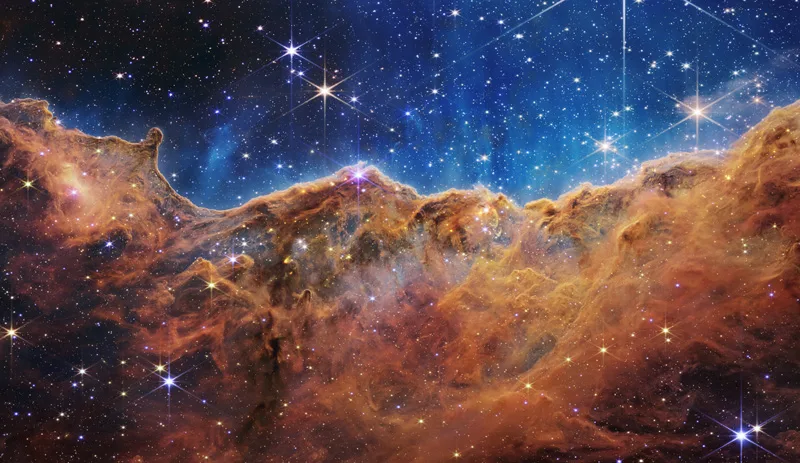
Webb's first images spark awe and wonder about the universe
The next-gen space telescope is finally putting its astounding capabilities on display.
Astronomy has just taken a giant leap forward!
Thanks to the new James Webb Space Telescope, we now have our farthest, clearest look out into the cosmos and stunning new views of the wonders of our universe.
In a much-hyped media event on Tuesday, July 12, NASA, the European Space Agency, and the Canadian Space Agency revealed the very first full-colour images and spectra from the James Webb Space Telescope. It's been over six months of waiting since the telescope launched in December 2021, and the results were indeed worth it.
"Today is the start of something truly revolutionary in astronomical research. The universe will never look the same again — it will appear grander, more dynamic, and more detailed than ever before," Kenneth Sembach, the Director of the Space Telescope Science Institute (STScI), said in a statement.
On Monday, we presented our previous "best looks" at Webb's first targets. Here is what the new telescope has now shown us.
Galaxy supercluster SMACS 0723
In a tiny section of the universe, smaller to our view from Earth than a grain of sand held at arm's length, lies a massive supercluster of galaxies named SMACS 0723. Short for Southern MAssive Cluster Survey 0723, SMACS 0723 is remarkable because the cluster's collective gravity warps the very fabric of spacetime around it into an immense cosmic lens.
This made it a prime target for Webb's first 'deep field' look at the universe. Revealed in a special White House event on Monday night, this new image of SMACS 0723 was first presented to the world by U.S. President Joe Biden.
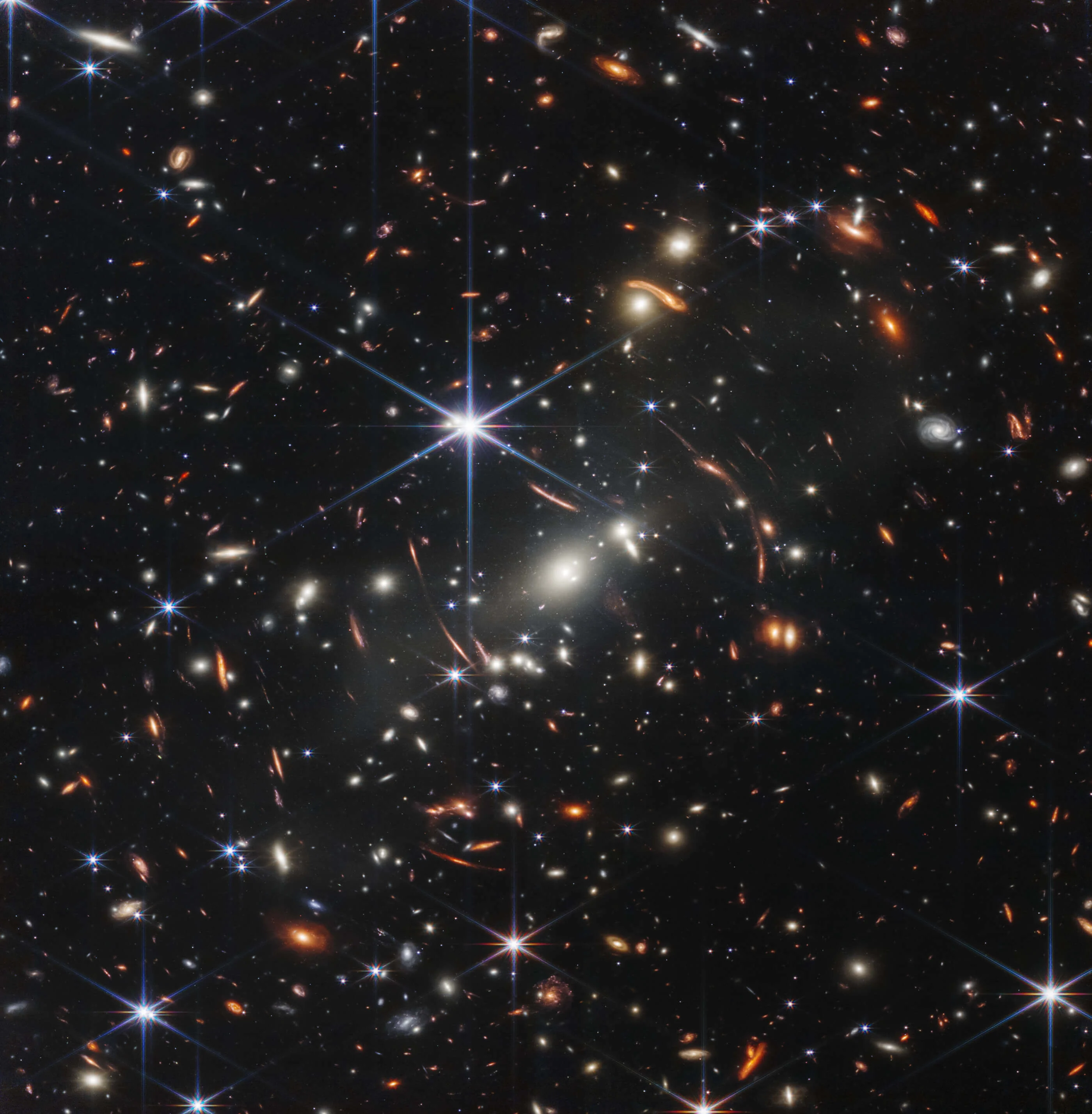
CLICK/TAP TO ENLARGE! Using the Near-Infrared Camera (NIRCam), the James Webb Space Telescope has produced the deepest and sharpest infrared image of the distant universe to date — Webb's First Deep Field. Credits: NASA, ESA, CSA, and STScI
In the above image, the 'spiked' objects are mostly stars in our own galaxy, plus a few bright nearby galaxies. But, no matter how faint, every other splotch or point of light in the view is a galaxy containing millions to billions of stars of its own!
Due to how the different wavelengths of infrared light were combined for this image, the closest galaxies to us show up in white. In contrast, the most distant background galaxies appear orange or red. The cosmic lens produced by those white foreground galaxies magnifies objects in the background. Due to the 'bumpy' nature of that gravitational lens, though, it causes some to appear bent and warped. However, it also allows us to see some galaxies as they were over 13 billion years ago.
Before this, our best view of the galaxy cluster was from the Hubble Space Telescope, which took days of observations to produce. By comparison, it took Webb only around 12 hours to gather the light to give us the above look. That is where the real power of this next-gen telescope lies — it has greater resolution, but it can also collect its scientific data faster, allowing astronomers to explore more of the universe than ever before.
Watch Below: Out of this World - Compare the clarity of James Webb telescope's images with Hubble's
WASP-96 b
When NASA announced that one of the images released would be the spectrum of an exoplanet, it caused some excitement in the space community. Observing an alien planet as it passes in front of its star allows a powerful telescope to pick out the chemical elements in the planet's atmosphere, thus revealing more about its nature.
Using Canada's Near-Infrared Imager and Slitless Spectrograph instrument (NIRISS), the team targeted a gas giant planet known as WASP-96 b. At roughly half the mass of Jupiter, this alien world is remarkable for two reasons. First, it's incredibly close to its star, taking less than 4 days to complete one orbit. Second, based on previous observations, it did not appear to have any clouds — a strange result, given the cloudy gas giants in our own solar system.
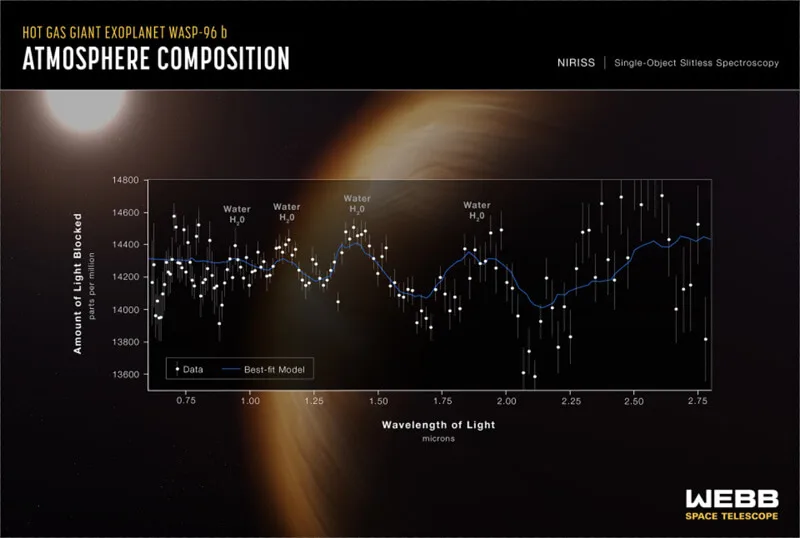
CLICK/TAP TO ENLARGE! A transmission spectrum made from a single observation using Webb's Near-Infrared Imager and Slitless Spectrograph (NIRISS) reveals atmospheric characteristics of the hot gas giant exoplanet WASP-96 b. In the background is an illustration of what this hazy planet may look like. Credits: NASA, ESA, CSA, STScI
According to NASA: "The spectrum of WASP-96 b captured by NIRISS is not only the most detailed near-infrared transmission spectrum of an exoplanet atmosphere captured to date, but it also covers a remarkably wide range of wavelengths, including visible red light and a portion of the spectrum that has not previously been accessible from other telescopes (wavelengths longer than 1.6 microns). This part of the spectrum is particularly sensitive to water as well as other key molecules like oxygen, methane, and carbon dioxide, which are not immediately obvious in the WASP-96 b spectrum but which should be detectable in other exoplanets planned for observation by Webb."
By measuring how much water vapour is in an exoplanet's atmosphere, along with elements like carbon and oxygen, scientists can gain keen insights into the planet's conditions. In many cases, this will help us understand the variety of planetary environments. For some, it may reveal the planet's potential habitability, or perhaps even the presence of life there!
The Southern Ring Nebula
Roughly 2,000 light years from Earth, the remains of a dead star have expanded outward to form a planetary nebula known as NGC 3132, aka the Eight-Burst Nebula, or the Southern Ring Nebula.
An image by Hubble from 1995 revealed a fuzzy, vaguely egg-shaped nebula with two stars in its empty core.
The new look from Webb brings the entire nebula into incredibly sharp focus.
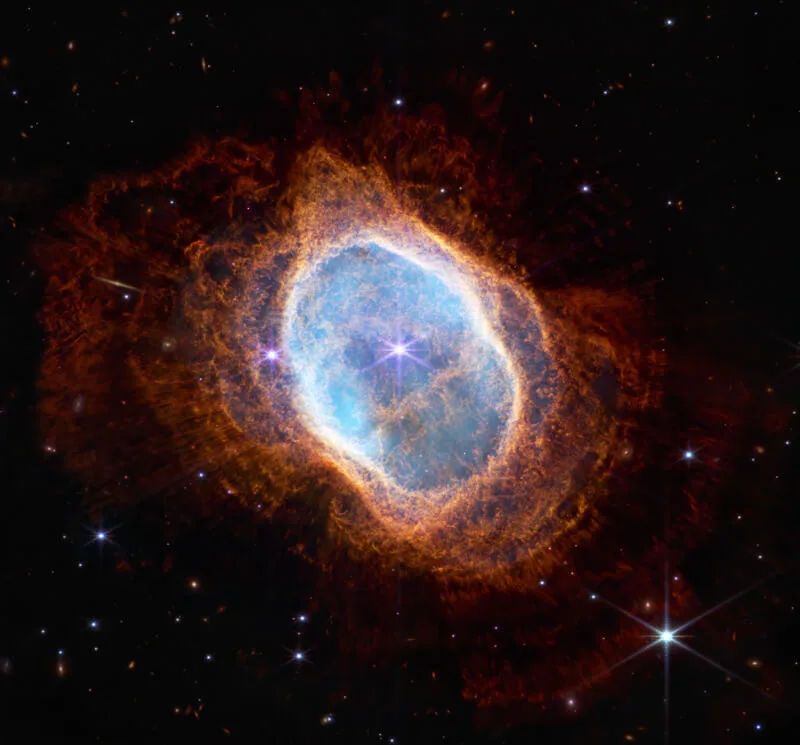
CLICK/TAP TO ENLARGE! The Southern Ring Nebula is shown in unprecedented detail here, as captured by Webb's NIRCam instrument on June 3, 2022. Credits: NASA, ESA, CSA, STScI
According to NASA: "The bright star at the centre of NGC 3132, while prominent when viewed by NASA's Webb Telescope in near-infrared light, plays a supporting role in sculpting the surrounding nebula. A second star, barely visible at lower left along one of the bright star's diffraction spikes, is the nebula's source. It has ejected at least eight layers of gas and dust over thousands of years. But the bright central star visible here has helped "stir" the pot, changing the shape of this planetary nebula's highly intricate rings by creating turbulence. The pair of stars are locked in a tight orbit, which leads the dimmer star to spray ejected material in a range of directions as they orbit one another, resulting in these jagged rings."
While this image was released to spark our wonder about the universe and the capabilities of Webb, scientists are already delving deeper into this view and will present their research soon.
Stephan's Quintet
Discovered by French astronomer Édouard Stephan in 1877, these five galaxies comprise the first compact galaxy cluster ever found. Located around 290 million light years away in the Pegasus constellation, it features five galaxies — three individual ones in close proximity to two others that are in the process of merging. Studies of this grouping have predicted that four of these five will eventually merge to form one immense galaxy.
While Hubble's view of Stephan's Quintet was amazing, Webb's instruments peered through the dust surrounding these galaxies to reveal unprecedented details about the cluster.
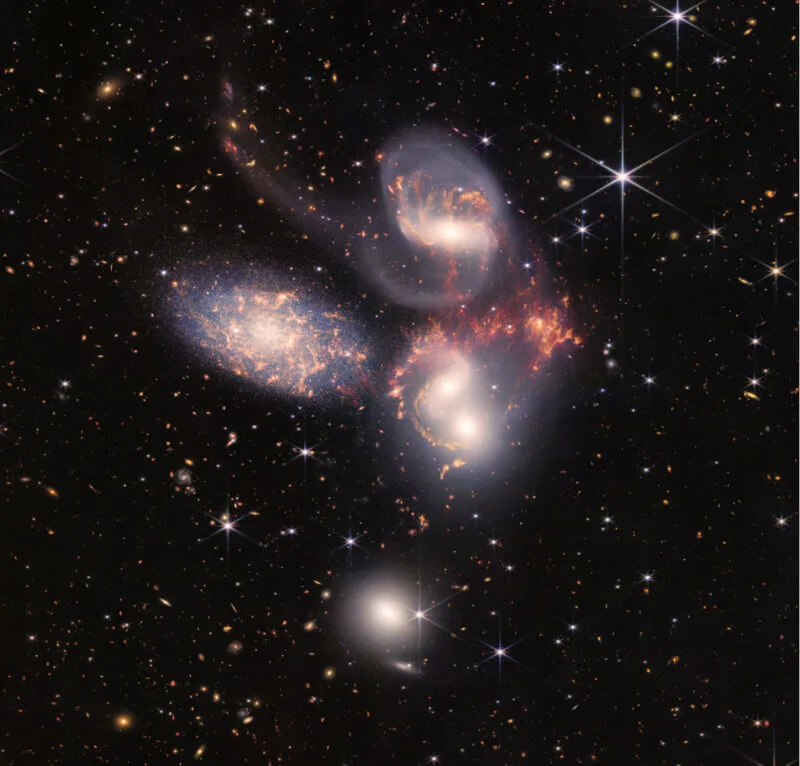
CLICK/TAP TO ENLARGE! This composite NIRCam-MIRI image uses two of the three MIRI filters to best show and differentiate the hot dust and structure within the galaxy. MIRI sees a distinct difference in colour between the dust in the galaxies versus the shock waves between the interacting galaxies. To highlight that difference, MIRI data has been given distinct yellow and orange colours, in contrast to the blue and white colours assigned to stars at NIRCam's wavelengths. Credits: NASA, ESA, CSA, STScI
Also, as an added bonus, this image of Stephan's Quintet contains far more than just five galaxies. Besides the dozen or so foreground stars in the view, thousands of other galaxies are also visible here, lurking in the background!
The Carina Nebula
The final image presented on Tuesday is of a section of the Carina Nebula — an immense cloud of dust and gas located around 7,600 light years from Earth. Measuring roughly 500 light years across, this nebula is a region of intense star formation and is already home to numerous massive stars.
As with the other targets, Hubble had given us our best views of it so far. Results from HST's observations were shown in the visible light to highlight all of the glowing dust and gas, while near-infrared views revealed some of the extra details of the dust clouds.
Webb's view of it takes that to the next level!
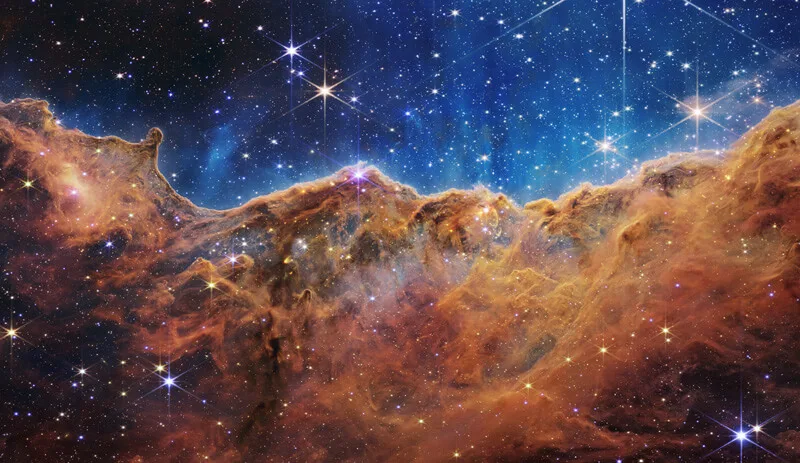
CLICK/TAP TO ENLARGE! What looks much like craggy mountains on a moonlit evening is actually the edge of a nearby, young, star-forming region NGC 3324 in the Carina Nebula. Captured in infrared light by the Near-Infrared Camera (NIRCam) on NASA's James Webb Space Telescope, this image reveals previously obscured areas of star birth. Credits: NASA, ESA, CSA, STScI
The above image combines different wavelengths of infrared light, thus seeing different layers of the clouds and even straight through them.
NASA says NIRCam has unveiled hundreds of previously hidden stars in the view, plus numerous background galaxies and several prominent features:
The "steam" that appears to rise from the celestial "mountains" is actually hot, ionized gas and dust streaming away from the nebula due to intense ultraviolet radiation
Dramatic pillars rise above the glowing wall of gas, resisting the blistering ultraviolet radiation from the young stars
Bubbles and cavities are being blown by the intense radiation and stellar winds of newborn stars
Protostellar jets and outflows, which appear in gold, shoot from dust-enshrouded, nascent stars
A "blow-out" erupts at the top-centre of the ridge, spewing gas and dust into the interstellar medium
An unusual "arch" appears, looking like a bent-over cylinder
WATCH: Canadian camera on Webb showed deepest view of our universe at the time
There's more on the way!!
Of all the reveals and announcements presented on Tuesday morning, one stood out from the rest.
Rather than only seeing new content from this telescope when there are major science announcements, the Webb team will be presenting new images to the public to showcase even more of the telescope's capabilities each week.
This will allow us to more fully experience the awe and wonder that results from peering into the depths of our universe!






